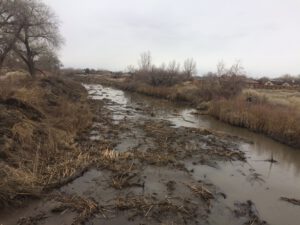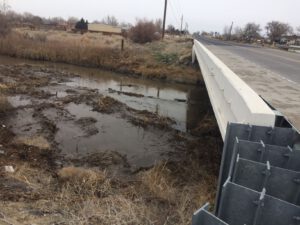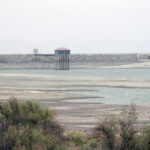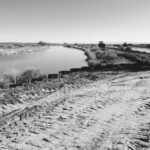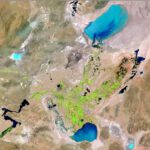Resolving old disputes and hard feelings is a difficult but necessary step toward ensuring lasting cooperation. The Truckee-Carson Irrigation District (TCID) had to do precisely that to forge a better relationship with the Bureau of Reclamation, which allowed the district to improve its water infrastructure, address urgent emergency situations, and protect its communities. TCID General Manager Rusty Jardine and Board President Ernie Schank were among those who led the effort to resolve the district’s disputes with Reclamation and other stakeholders. They have also helped pave the way for new leadership to lead the district into the future. Mr. Jardine and Mr. Schank spoke with Irrigation Leader’s editor-in-chief, Kris Polly, about the origins of the district’s challenging relationship with Reclamation, how it was able to overcome those disputes, and the benefits that the improved dynamic has brought to the district and its water users.
 Kris Polly: Can you give us an overview of the size of your district, its water sources, and the number of people you serve?
Kris Polly: Can you give us an overview of the size of your district, its water sources, and the number of people you serve?
Ernie Schank: This district is approximately 60,000 acres. The original project size was 72,800 acres, and it was all agricultural land at that time. We serve the Fernley area and all of the Carson Desert Sink, which is in the Fallon area. We have 350 miles of canals and laterals that serve water, as well as the exact same amount of drainage ditches. That makes us responsible for approximately 700 miles of ditches either for delivery or drainage. The project has one major dam, the Lahontan Reservoir, which has a capacity of 312,000 acre-feet of water when completely full. We can also divert water from the 720,000 acre-foot reservoir of Lake Tahoe for drought protection purposes.
Rusty Jardine: We have approximately 2,500 water users in the district, but the U.S. Fish and Wildlife Service (FWS) is our biggest water user due to the government initiativesto purchase water rights for wetlands purposes. FWS owns 13 percent of the district’s water rights, and it uses that water to serve the Stillwater Refuge. There is a chapter of the Nevada Revised Statute that provides for that use, and we started our life as a district in 1918 by petition.
Our water is stored in Lahontan Reservoir and Lake Tahoe, which means we have two major river systems that contribute to our water supply. One is in Alpine County, and the other comes from Lake Tahoe through the Truckee River. We derive our supply from the Truckee Canal and the Truckee River directly to the Truckee Division. The canal originates off the river at Derby Dam, which is the first facility ever built by Reclamation. Under state law, a water right is appurtenant to the lands within the projects, meaning the landowners hold the corresponding water rights for their land. This is different from many other districts under Reclamation’s jurisdiction.
Ernie Schank: Our project was one of the first five Reclamation projects to be authorized in 1903. The original authorization was for approximately $7 million, and that money was spent before the drainage system could be built. After the project was built, people would water their crops, but the water would stand after the land was watered more than a few times because the water table was so high. Hence, TCID was organized in 1918 under Nevada state law so that bonding could be entered into to complete the drainage system.
Up until the early 1960s, the project mostly went along without issue, but at that time, two factors became more prominent. One of those was the Endangered Species Act, and the other was legislation settling Native American water rights claims. Our evolution as a district really began during that time, and we had to tighten our belts in order to comply with the rules and regulations that have been imposed on us as a result. All those factors created tension that existed between water users and Reclamation until approximately 2 years ago.
Kris Polly: What led to the improvement in relations between Reclamation and the district?
Rusty Jardine: The pivotal development was that we finally resolved much of our outstanding litigation. One element was the litigation that originated in 2008 after the embankment breach in Fernley. That incident resulted in nearly $1 billion in tort claims, and we finally settled with the plaintiffs in that class action suit for $18.4 million. We held interest in the storage rights and dam works at Donner Lake, and we were able to sell that interest for a sum that was sufficient to pay off the settlement.
 Ernie Schank: We were involved in numerous lawsuits going back to the 1960s and 1970s, both as plaintiffs and as defendants. There was a combination of legal issues that have clouded us for decades, and we were able to settle them all by resolving the outstanding litigation against us. In 2008, a month after the breach, we were served with a federal indictment against four of our employees, including our district manager, as well as the district itself. Eventually there was a settlement, and the federal court set aside all the indictments on the condition that the district manager resign and a new manager be appointed. We had an interim manager before hiring Rusty for the position. Settling the litigation caused a generational shift, which combined with the changes we made, including hiring Rusty, brought about this improved dynamic. It was difficult to convince our people to bury the hatchet and end the litigation, but they eventually agreed we were better off.
Ernie Schank: We were involved in numerous lawsuits going back to the 1960s and 1970s, both as plaintiffs and as defendants. There was a combination of legal issues that have clouded us for decades, and we were able to settle them all by resolving the outstanding litigation against us. In 2008, a month after the breach, we were served with a federal indictment against four of our employees, including our district manager, as well as the district itself. Eventually there was a settlement, and the federal court set aside all the indictments on the condition that the district manager resign and a new manager be appointed. We had an interim manager before hiring Rusty for the position. Settling the litigation caused a generational shift, which combined with the changes we made, including hiring Rusty, brought about this improved dynamic. It was difficult to convince our people to bury the hatchet and end the litigation, but they eventually agreed we were better off.
Kris Polly: How has that new dynamic with Reclamation paid off for the district?
Rusty Jardine: In 2017, we received over 100,000 acre-feet of water in Lahontan Reservoir in only 10 days. The reservoir’s capacity is only 40,000 acre-feet, and forecasts showed that even more water was on its way. We had to quickly come up with plans for how to deal with that kind of runoff, and Reclamation was there with us every step of the way. Our project was never authorized or intended to be a flood control project, but we had to operate in a flood operations mode for over half of 2017. The success in that effort led to better outcomes for everyone involved. We were able to divert the runoff water around our community to prevent it from flooding any homes.
Despite that success, our ongoing forecast models told us we would need more capacity to deal with the runoff over several months, and we decided to provide for diversion off the V Line canal, which is one of the canals that branches off from Carson Diversion Dam. The water was diverted off the canal, sent into the open-terrain desert, and out into the valley to what is known as Carson Lake. From there, the water went to multiple oversize culverts that we built with the help of the Nevada Department of Transportation (NDOT). Highway 95 bisects Carson Lake, and we had to install pipes to connect the two portions of the lake to hold the water without flooding the highway.
Ernie Schank: When we began that effort at Highway 95, we did not have a structure to hold back the water while the work was being done. Fortunately, Reclamation designed an emergency weir that used available space in the canal. Some concrete work was also required to make the emergency spillway, but it only took 33 days for us to get everything built after we became aware of the problem. That kind of expediency is almost unheard of for Reclamation, particularly given all the environmental and engineering requirements. Another problem was that the water needed somewhere to go once Carson Lake reached its capacity limit. Before the project was built, water would go out into the Stillwater area, where there is now a large federal wildlife refuge. We had to move the water through the refuge and out into the Carson Sink. To do that, we had to cross another major highway, and we brought in NDOT to lay culverts as it had before. Lastly, we had to dig 17 miles of new lateral ditch to move the water to the refuge.
This was also a big public relations boost for the district. We are not a flood management district, and we could not have done this work by ourselves. Reclamation, the city, the county, and the state all had to jump in and help in various ways. Reclamation personnel were also literally in the trenches with us, working to get these projects finished as quickly and efficiently as possible. We emerged from this incident with not only a better relationship with the various agencies, but also a better reputation in the community and new infrastructure to protect our communities.
Kris Polly: What are some of TCID’s priorities for the future?
Rusty Jardine: One priority is to bring in and develop new, young leaders who can carry the torch in the future as people like Ernie and I prepare to step away from serving after so many years. A lot of institutional knowledge will be lost when Ernie and I step away, and we need to retain and pass on that knowledge to others who can continue to use it.
Ernie Schank: The small population base we have in the district has always made it difficult to have a lot of depth at many of our positions. But with the end of the litigation, we have some money freed up that we are using to be at least two people deep at all district positions that are important to maintenance and operations. The goal is to ensure we have extra people who can step in at a moment’s notice and take over a position if necessary.
Rusty Jardine: We are coming to the end of our contract term with Reclamation, and we have to renegotiate that agreement in a few years. That will be very important for the district’s future. Over the course of the contract, we have strived to provide a greater level of water measurement and improve our delivery efficiency. We have come a long way, but we are still not where we need to be.
Ernie Schank: Another goal for the next few years is to find the balance between meeting our environmental requirements and keeping the community vibrant. We have to sustain both the ecosystem and the community for the future, and that will require some modernization, but it has to be done with an eye to how it will affect people who live here. If we can do that, the project may well be here sustaining this region for another 100 years.

